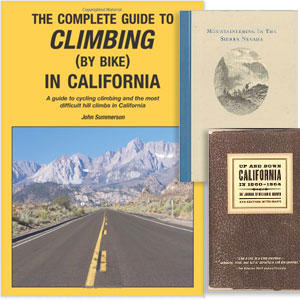If there is a theme I (Slowman) apply most often to most technique-related subjects it's this: In the absence of a very good reason not to, emulate the technique used by the best in the world. It doesn't matter what the sport is. If you notice a large number of professional athletes swinging a bat or a club more or less the same way, throwing or shooting a ball the same way, emulate this.
There are two exceptions to this. Do not use the intermittent (alternate, or every fourth) breathing patterns many top swimmers use. Oxygen is your friend. Breathe as often as you can.
And do not descend like so many of the pros you see in grand tours. How dare I?

What you'll read below is general and refers to both road and tri, but there are specific elements to tri that I will cover separately, not here. I'm also not going to cover tucking, nor what to do if you get a flat on a high speed descent. I will talk about all of this, just not here.
Back to pro tour racers. Remember, they are allowed to use the whole road and you aren't. Now, maybe because they get to use the whole road, they open themselves up to extra trouble. If you watch helicopter images of the Tour de France you'll notice many of these riders entering the turn early – hitting the apex much earlier than I recommend. If you're able to use the entire road, and you start on one side of the road and hit the road's inside tangent dead center in the curve, you'll leave the apex almost at a right angle to the opposite shoulder. We amateurs only get to use half the road and while that gives us less room to maneuver, it keeps us from ever finding the noses of our bikes pointed perpendicular to the road.
So many times we see shots of professional racers overshooting turns as they exit, on the shoulder of the road, sometimes tumbling over fences and barriers, often beginning their acceleration out of the turn very late. Do you remember Thomas Voeckler's infamous descent on Stage 17 of the 2011 Tour de France?
To be sure, part of this is because they're riding at their limits. Okay. But I'm going to talk about how to descend relatively fast while staying as safe as you can if you're going to descend at speed.
Motorcycle racers are all familiar with the term late apex. Some might argue that's not applicable to bicycles, because the point of late apex is to get your motorcycle pointed straight more quickly, so that you can stand on the accelerator sooner. Fair point. We don't turn throttles out of corners in cycling.
But that's not the only reason for late-apex lines. Going into a turn, you want to be ready for what you might not be able to see on the other side: a decreasing radius to the turn you're in; an elevation drop to the road in the back half of the turn; another turn right after the one you're in; or sand or gravel in the road.
This makes blind turns the most dangerous, because you don't know the profile of the downhill part of the turn you can't see, not to mention whether there's a turn immediately following the turn you're currently negotiating. There are a number of these blind turns in the video.
This video shows 4 or 5 turns edited back to back, from the rather bumpy point of view of a Garmin Virb on my handlebars, along with some smoother frames from the Sony Action Cam Mini atop my helmet (shows you how much of a shock absorber your elbows are). This is a moderate descent, top speed of 45mph, the turns more like 25 or 30mph.
I try to do most or all of my braking before I hit the turn. My preference, though it doesn't always work out that way, is to have my hands ready to brake, but to not brake during the turn.
The subtitle of this video is "look where you're going" and it's not meant as an imperious exhortation but as a point of technique. I'm aiming for an apex late in the turn, and my eyes are focused on where I intend to hit that late apex.
Invariably when I read an article on descending there's, "lean your bike and not your body." I just don't find this helpful advice. Even if there is a technical truth here – and I am not sure there is – of all the things I might think about during a descent, this is way down the list.
The other unhelpful topic is countersteering. On a motorcycle, maybe, but on a bicycle you'll spend a lot of time scratching your head trying to be a better descender by mastering countersteering.
If you do most or all of your necessary braking as you enter the turn rather than during the turn, and concentrate on hitting the inside tangent of your turn late, i.e., the late apex, this will help you descend at speed, with confidence, and better prepared for the part of the road you can't see.


